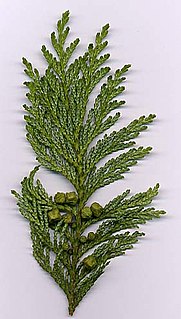
Chamaecyparis, common names cypress or false cypress, is a genus of conifers in the cypress family Cupressaceae, native to eastern Asia and to the western and eastern margins of the United States. The name is derived from the Greek khamai, meaning ground, and kuparissos for cypress.

Plumeria is a genus of flowering plants in the dogbane family, Apocynaceae. Most species are deciduous shrubs or small trees. The species variously are indigenous to Mexico, Central America and the Caribbean, and as far south as Brazil, but are grown as cosmopolitan ornamentals in warm regions. Common names for plants in the genus vary widely according to region, variety, and whim, but Frangipani or variations on that theme are the most common. Plumeria also is used directly as a common name, especially in horticultural circles.
Robert Brown's taxonomic arrangement of Dryandra was the first arrangement of what is now Banksia ser. Dryandra. His initial arrangement was published in 1810, and a further arrangement, including an infrageneric classification, followed in 1830. Aspects of Brown's arrangements can be recognised in the later arrangements of George Bentham and Alex George.

Plumeria obtusa, the Singapore graveyard flower, is a species of the genus Plumeria (Apocynaceae). It is native to the West Indies including Bahamas; southern Mexico, Belize, Guatemala, and Florida. but widely cultivated for its ornamental and fragrant flowers around the world, where suitably warm climate exists. It is reportedly naturalized in China.

Squilla is a genus of mantis shrimp. It includes the following species:

Neverita is a genus of medium-sized to large sea snails, marine gastropod molluscs in the family Naticidae, the moon snails

Leucophlebia is a genus of moths in the family Sphingidae first described by John O. Westwood in 1847.
Hopia obtusa is a species of grass commonly known as vine mesquite. This plant was treated as Panicum obtusum until recently when more molecular and genetic material revealed new information about it. Hopia obtusa is now placed in the monotypic genus Hopia.
Tamamushia virida is a species of beetles in the family Buprestidae, the only species in the genus Tamamushia.
Neotamandua is an extinct genus of anteaters that lived in the Miocene to Pliocene in South America. Their fossils have been found in the Miocene Collón Cura Formation of Argentina, the Honda Group at La Venta in Colombia and the Pliocene Araucano Formation in Argentina. Its closest living relatives are the giant anteater and tamanduas. The species Neotamandua borealis was suggested to be an ancestor of the giant anteater. Patterson (1992) suggested the Neotamandua fossils are very similar to Myrmecophaga, which would mean Neotamandua may be congeneric with Myrmecophaga.
Urceolina is a genus of South American plants in the Amaryllis family, all native to Perú.
Myrtella is a genus of plants in the Myrtaceae described as a genus in 1877. It is native to New Guinea and to some islands of the western Pacific.
- Myrtella beccariiF.Muell. - New Guinea, Solomon Islands
- Myrtella bennigseniana(Volkens) Diels - New Guinea, Caroline Islands, Mariana Islands
Euaspis edentata is a species of leaf-cutting bee in the genus Euaspis, of the family Megachilidae. It is found from parts of India, and Sri Lanka.
Oreta obtusa is a moth in the family Drepanidae. It was described by Francis Walker in 1855. It is found in India, China, Myanmar and Indonesia.
Azenia virida is a species of owlet moth in the family Noctuidae. It is found in North America.
Azenia was a deme of ancient Attica between Anaphlystus and Sunium.








